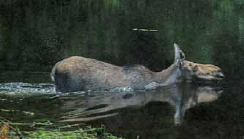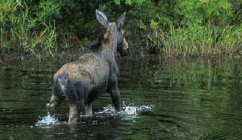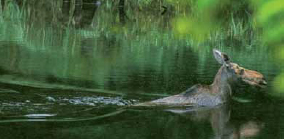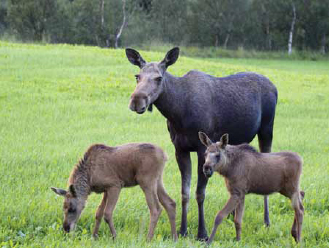The morning had not amounted to much. It was cold and overcast, with a raw wind that carried a few flakes of snow. The leaves had not yet popped, the little early spring flowers had not yet bloomed, and the turkeys were not gobbling. Not for me, anyway.
So I picked up an old logging road and walked thinking that if I didn’t hear anything further along the ridgeline, then at least I would feel a little warmer. It was too early to quit and go back home for breakfast and the day’s obligations.
I had walked a half mile, or so, when I saw a freshly broken limb that had grown out across the logging road at about my eye level. I wondered if a hunter had done that. It is uncomfortable to know that you are sharing the woods with another hunter and that he could be close. Might even be watching you.
Where I’d been feeling a little bored and aimless and had been walking without much point to it, my senses were now on alert.
I checked the ground, where it was wet, looking for a boot track.
Didn’t find one. But there were some prints left by a very large hoof.
I had been through this before, not far from here, so I knew what I was dealing with and it gave the morning a sense of real possibility.
I was on the trail of a moose.

 There are, perhaps, 3,000 moose in Vermont. Which is enough. These are big animals—the biggest you’ll find in this state—and they need lots of room. They favor big woods like those of the state’s wilderness areas. But now and then one will show up in civilized surroundings. In a farmer’s fields. Someone’s backyard. Or, a couple years ago, on the ski trails of Sugarbush resort where a bull moose of some considerable size actually chased a skier. Someone who observed the incident said that he wouldn’t have believed it possible to run that fast while wearing ski boots.
There are, perhaps, 3,000 moose in Vermont. Which is enough. These are big animals—the biggest you’ll find in this state—and they need lots of room. They favor big woods like those of the state’s wilderness areas. But now and then one will show up in civilized surroundings. In a farmer’s fields. Someone’s backyard. Or, a couple years ago, on the ski trails of Sugarbush resort where a bull moose of some considerable size actually chased a skier. Someone who observed the incident said that he wouldn’t have believed it possible to run that fast while wearing ski boots.
Sometimes, however, surprise encounters between a human and a moose do not end with mutual flight.

 That moose, to put a charitable face on things, was no doubt confused and perhaps even feeling a bit of panic. What, in his life experience, could have possibly prepared him for a bunch of creatures, gaudily colored and shooting down the hillside at impossibly high speeds?
That moose, to put a charitable face on things, was no doubt confused and perhaps even feeling a bit of panic. What, in his life experience, could have possibly prepared him for a bunch of creatures, gaudily colored and shooting down the hillside at impossibly high speeds?
No harm came of that encounter. The skiers came away with a story to tell around the dinner table that night. No telling what lasting memories, if any, the moose carried away from the experience.
Surprise Encounters
Most encounters in Vermont between moose and humans end that way. Not very many weeks before I sat down to write about moose in Vermont, one appeared at the back door of the house where a woman I know lives. They were both surprised and made an immediate effort to get some separation between them. The story was good for a few days of conversation at Williams store.
Sometimes, however, surprise encounters between a human and a moose do not end with mutual flight. Occasionally, a moose will—like the one at Sugarbush—go on the offensive. Moose can be belligerent. Especially the bulls when it is mating season.
I’ve seen it and lived to tell the tale.
The action did not take place in Vermont but it did involve a moose and they are the same, pretty much wherever you find them. In this case, that would have been Wyoming.
My wife and I were camping and exploring in a big, remote section of the Bridger National Forest. We had been having a fine time hiking and fishing and examining with a kind of reverence the still visible tracks left by wagons that had crossed the mountains here on the Oregon Trail. There was a tombstone in one high meadow to mark the grave of a woman who had died along the way, giving birth. It was a solemn, mournful place.
We had a fine, new 4X4 SUV loaned to me by the manufacturer so that I might road test it for a magazine that employed me to do this, from time to time. It was a really nice vehicle and I was trying to see just how much it could take on the Forest Service’s two-track roads.
So I was moving at a pretty good clip when the road took a bend around a low place along the banks of a creek. I came around a blind curve grown up in aspen and willow and there, thirty or forty feet ahead, was a bull moose. A yearling, judging by the size of his shovelshaped antlers, but plenty big enough. Well over five hundred pounds.
He had a couple of cows with him and I expect he was feeling apprehensive about that. There had to be some full-grown bulls in the area, willing and eager to lock horns (as they say) and steal his harem. So he was spring loaded and ready to fight … anything. Man, beast or machine. To include my jaunty SUV.
He dropped his head and pawed at the dirt. My wife said something about how the prudent thing might be to get out of there. The cows merely observed. The little bull made a false charge by which time I had recovered my wits enough to find reverse gear. Before the moose could make a genuine attack, I had backed out of there, apologizing for interrupting his love life.
“Close,” my wife said.
“Yes,” I said. “And I’m kind of sorry about that.”
“Why?” she said.
“Well, it might have been interesting to see how the vehicle would have held up to a moose attack. I don’t suppose anyone has ever done a road test for Automobile magazine that included that.”
It would have been a first, my editor agreed when I told him about it. “And you would have had a tough time getting a car from those people ever again.”
Deadly Collisions
If I’d dodged one, a lot of people aren’t so lucky. At last count, in Vermont, 18 people have been killed in vehicle collisions involving a moose.
These encounters are deadly for the obvious reason— the moose is a big animal. Not quite the immoveable object, but close enough. Drivers frequently hit deer on Vermont’s highways, but those animals never weigh much more than 150 pounds and usually much less. So the damage is mostly to sheet metal. A moose will go 700 pounds, at least, and sometimes twice that. Also, the animal stands so high that the collision usually takes the legs out and the body comes in through the windshield.
Moose cross highways, of course, if there is one between them and where they want to go. They are also drawn to roads for the salt used to melt ice and snow. They will linger on the shoulders of a road, licking the accumulated salt and when they do this at night, they are particularly hazardous. First, because their eyes are higher than the beams of headlights, there is no reflection to warn the driver. Also, because the coat of a moose is a dark, subdued brown that does not show well in the headlights, drivers are often on top of the animal without time to react.
This happened to me, one late winter night, coming home from a business trip to New York. I was on Route #7, just barely beyond the Arlington exit, and traveling at what is politely called “a high rate of speed.” I wanted to get home.
The moose was two car lengths from my bumper when I saw him. A sort of spectral figure, just off the blacktop. I missed him by a foot and it wasn’t until I looked in the mirror that I knew with certainty what I had almost hit. My hands were hard on the wheel and my feet were light on the gas the rest of the way home.
There is something comic about the moose when he appears, unaware of your presence. Because while it is a big, strong, and formidable animal, the moose is also ungainly and looks like it was built with parts out of proportion to one another.
Moose Encounters
Most moose encounters—mine, anyway—are less exciting than that and thanks be. But they are always thrilling. You are seldom prepared fto come face to face with a moose. And you are, if possible, even less ready for what you see.
There are planned encounters. In the summer, moose will come to ponds— especially those made by beaver—to cool off and to eat some of the aquatic vegetation that they seem to be fond of. If you know of a pond that is being regularly visited, you can set up— back a ways, so you’ll need binoculars—and wait until the moose shows up for a swim and a snack.
Wildlife experts assume that a few young moose are killed by coyotes or bears. But the mature specimen has nothing to fear except the hunter who has gotten lucky in the lottery.
There is something comic about the moose when he appears, unaware of your presence. Because while it is a big, strong, and formidable animal, the moose is also ungainly and looks like it was built with parts out of proportion to one another.
The sight of a deer or bear or coyote—the other apex creatures of the Vermont woods—does not make you smile the way you do when you see a moose. These animals are graceful and seem to fit with a sort of Platonic notion of wildness. They look like they have been shaped by the millions of years of natural selection to survive and prosper in the wild. They have grace. Deer, especially, look built for quick and nimble flight. Bears for power. Coyotes for stamina and perseverance.
A moose, however, looks like the designer didn’t get the specs right. Or that it was built out of spare and leftover parts.
First, there is the business with the legs. The forelegs are much longer than the pair in the rear. This makes for an awkward gait with the animal seeming, at slow speeds, a little unsteady. The design makes it easier for the animal to clear large fallen logs, something it must do often since it is too big to move nimbly around obstacles. But what it gains in practicality, the design loses in aesthetics.
The moose has a hump on its back. Not so pronounced as that of a camel but it is still there and it makes the lines less than pleasing. The neck is short and the nose is long. Very long. As are the ears. The combination gives the animal a sort of bewildered look.
This is what you see, if you are watching one through binoculars as a moose cools off and feeds in a beaver pond. “Yes,” you might think, you can see how they came up with the comic character of Bullwinkle the Moose.
But the moose isn’t looking for laughs. It has skills. It can run much faster than you would expect, especially in short bursts, and when it feeds on aquatic plants it can dive up to 20 feet deep into the water. What moose lack in grace, they make up for in power and when you’ve seen what they can do to a stand of conifers during the rut, you cannot help but feel something like awe. This, you think, is an apex animal. Wild, powerful, and undeniable.
There were few moose in all of Vermont 100 years ago. The state had been heavily logged and the cleared ground did not make for good moose habitat. But the forests regenerated and came back. The beaver, which had disappeared from Vermont, was re-introduced to the state in 1932 and went right to work doing what beaver do. This further expanded moose habitat. The animal spread from its range in Maine, down across New Hampshire and into Massachusetts and Vermont.
The moose is, thus, part of a story that, in my opinion, is insufficiently celebrated—the return of the wild. With the return of forested land and the application of sound management techniques, many creatures whose numbers had declined to insignificance or that had disappeared entirely, made a comeback. Sometimes a very dramatic one.
 Rebirth of Wilderness
Rebirth of Wilderness
Not so long ago in Vermont, deer were scarce. Turkey, non-existent. The bear population was near critical before it came back. And the coyote only recently appeared across New England and in the eastern states in general. Moose are part of this great rebirth of wilderness.
The moose population grew to the point that it required management, in the form of a hunting season with licenses given out on the basis of a lottery. fThis makes humans the animal’s only natural predator, other than a parasitic worm that moose can ingest when they eat snails that are nested in aquatic vegetation. The worm eventually works its way into the brain of the moose and causes pitiful symptoms of disorientation and, eventually, death.
Wildlife experts assume that a few young moose are killed by coyotes or bears. But the mature specimen has nothing to fear except the hunter who has gotten lucky in the lottery. I remember talking about this with a biologist who works for the state. We were at the end of a long day of hunting, successfully, timber rattlesnakes for a census he was conducting and we were rhapsodizing about the return of the Vermont wild.
A moose looks like the designer didn’t get the specs right. Or that it was built out of spare and leftover parts.
It was not yet complete, the biologist said. He expected two more species to appear, sooner rather than later. And at least one of them would certainly prey on moose.
This would be the wolf. The other species, the mountain lion, might take young calves as well.
They aren’t here yet, he says, but they are coming. For now, the moose is the invulnerable sovereign of the big woods. Which accounts for my excitement when I stumbled upon the trail of one on that otherwise fruitless morning in the early spring woods.
The track was easy enough to follow. There were prints big as pie plates and there were broken branches the size of baseball bats. And, at one point, I found a pile of pellets that were just slightly smaller than chicken eggs.
It was a trail I could have followed with my eyes closed and I stayed on it for a couple of miles until I began to get that old feeling of pointlessness. This was his turf and he knew how to negotiate it. I was just a clumsy interloper.
I ducked to clear an overhanging branch. Straightened up. And there, twenty steps ahead of me, was the moose. Big and not looking at all like Bullwinkle. Magnificent in his own way. Not a thing of beauty but a beautiful thing. Wild and at home.
He gave me a long look. Then decided that whatever I was, it was best to put some distance between us. He took off, running in that ungainly fashion, covering ground more quickly than you would have imagined, breaking branches on the way.
I turned around and started for home, leaving the wild behind me and thinking that it had been a very good morning. ◊
Geoffrey Norman is a writer who lives in Dorset.

